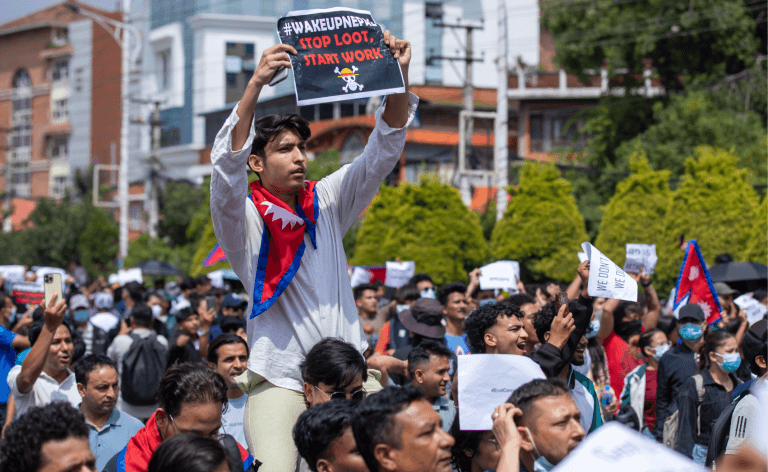Full Capacity: Gen Z discontent boils over
September 20 2025 by Mithun Varkey
Welcome to Full Capacity, a weekly briefing on all the most important developments of the past week with a personal take on the news from our editor-in-chief, Mithun Varkey, delivered to your inbox every Saturday.
IAN insight. The churn at Australian broker leadership seems to be continuing. Nearly all the top international brokers in the country have new leaders in place, and it does seem that the exit has been overwhelmingly from Marsh.
This week we reported that Marsh’s head of corporate and commercial for its Pacific business, Johannes-Daniel Veldsman, is set to move to Gallagher in March, joining Alex Lumby, who will become Gallagher Australia’s CEO.
Building new bonds. China’s large-cap insurers are becoming unlikely customers of Hong Kong’s booming convertible bond market amid a dramatic rally of Hong Kong-listed shares and sustained higher interest rates, according to bankers.
Large-cap, investment-grade insurers are rarely seen as issuers in the equity-linked market, which has long been a go-to funding source for high-yield and unrated issuers, particularly growth companies from the technology sector.
There has now been a trio of giant transactions from two of Hong Kong’s listed mainland Chinese insurers since July last year. Last week, China Pacific Insurance raised US$2 billion via the sale of a five-year convertible bond.
Running to stay put. The Australian federal government’s first National Climate Risk Assessment has delivered a stark, existential forecast: By 2050, around 1.5 million Australians will be at risk from rising sea levels and many face displacement and growing protection gaps because of rising sea levels and coastal flooding risks.
And it is increasingly clear that the only way to mitigate the risks is public-private partnership.
Earlier this week, Daniel Mulino, assistant treasurer and minister for financial services, and Andrew Hall, CEO of the Insurance Council of Australia, were in London to discuss how the insurance market could work with Australian organisations to create greater resilience to emerging disaster and natural catastrophe risks.
Mulino said the talks had thrown up a variety of potential solutions, including the UK’s Flood Re scheme launched in 2016.
“The example of Flood Re is one that we will need to very carefully look at,” he said.
“Each country has its own risk profile, and you cannot simply look to cut and paste existing solutions from elsewhere and bring it across. There are aspects of Flood Re we could look at.”
The delegation also visited Munich and Zurich to meet with European reinsurers.
Gen Z dissent amplifies political violence concerns
Last year had political violence underwriters on the edges of their seats, as almost half the world’s population took to the polls.
The much-ballyhooed “super-cycle” of elections in 2024 was heralded as a security concern, with whispers of local unrest and the far-reaching implications of electoral outcomes for foreign policy, trade relations, and supply chains.
Yet, for all the foreboding, the year proved largely uneventful – save for a notable student uprising in Bangladesh that forced the incumbent Sheikh Hasina government to take a bow in the latter half of the year.
While not a major insured loss event itself, it was the first clear signal of a troubling new phenomenon now spreading across the Global South: the simmering, organised discontent of Gen Z.
And spread it has. Indonesia was next, rocked by a surge of youth-led protests. These were swiftly followed by significant unrest in Nepal that led to the resignation of prime minister Khadga Prasad Oli.
The financial toll is already becoming clear: the Nepal Insurance Authority reports claims related to the protests will total approximately US$150 million.
In Indonesia, reports of widespread arson and looting point to “substantial losses” from property damage and business interruption.
The wave of dissent shows no sign of cresting. Timor-Leste has recently seen its youth pour into the streets to protest government plans to purchase new cars for politicians. Even the traditionally stable democracy of Kenya is now feeling the tremors of Gen Z mobilisation.
Gen Z dissent is a stand against a broad-based stand against systemic corruption, blatant extravagance, and entrenched nepotism.
According to Allianz Commercial data, the Asia-Pacific region recorded nearly 40,000 incidents of protests and riots in 2024 alone.
As this Gen Z uprising shows no signs of abating, we can reasonably expect these numbers to soar higher this year.
This is a core risk that political violence (PV) and strikes, riots, and civil commotion (SRCC) underwriters must monitor with a keen and urgent eye.
Interestingly, however, capacity in the PV market is expanding. New entrants, eager to provide specialised products, are fostering a softer market.
But underwriters will need to step up their game.
As Aon director Joe Gardner recently pointed out to IAN, “The PV will be expected to respond via specialist wordings, or specifically those which entail coverage for SRCC and malicious damage.”
The youth of today are not just voicing their frustrations; they are shaking the foundations of established political orders.
Insurers would also do well to listen closely.
People moves
In a notable move in the region that IAN first reported, reinsurer Ageas Re has hired Swiss Re’s Matthew Tong as its Asia representative in Hong Kong to build on its existing presence in the region.
Allianz Trade has appointed Hassan Omaish CEO of for Hong Kong, South Korea and Taiwan.
Sompo has announced the appointment of Alessa Quane as its new CEO of international markets.
Berkley Insurance Asia has appointed Jasmine Wan as head of casualty for greater China.
To keep up with the latest appointments across the region, don’t miss our weekly people move roundup.
-
Full Capacity: The year that was
- December 20
This week's newsletter discusses an IAN exclusive, Chubb's leadership switch, India's FDI increase for insurers, Vietnam's regulatory changes, Swiss Re Institute's nat cat analysis, the launch of a new APAC MGA and a 2025 round-up.
-
Full Capacity: Climate crisis strikes at Southeast Asia’s doorstep
- December 13
This week's newsletter discusses Guy Carpenter's lawsuit, this week's M&A deals, China Re's leadership change, Japan's nat-cat update, P&I renewals the South Asia floods.
-
Full Capacity: Reckoning after Tai Po tragedy
- December 6
This week's newsletter discusses broker deals in Australia, DB's Fortegra acquisition, storms in Southeast Asia and the leadership change at Allianz Re.
-
Full Capacity: Rise of the machines: AI transition and job losses
- November 29
This week's newsletter discusses the HK fire, nat cat updates, Munich Re's Australia push, Korean Re's Gift City entry, Roojai's PE funding, a P&I merger, and the AI dilemma for the insurance market.
-
QBE | Elevating customer experience, humanising claims: QBE Asia’s ‘Solutions in a Box’
Vastly improving turnaround times and personalising service delivery, QBE Asia’s award-winning, end-to-end bundled claims solutions is a game-changer for the insurance industry.
-
Beazley | What does cyber protection look like from day 1 to day 600 and beyond?
Cybersecurity is no longer just an IT concern, but a governance issue that belongs on the boardroom agenda.
-
Sedgwick | Preparing for the next storm
Insurance industry needs to recalibrate, invest in innovation and strengthen systems, talent and data practices.
-
Peak Re | From climate modelling to market opportunity: Forging a new clarity on Southeast Asia’s climate risk
Southeast Asia's protection gap: a crisis of clarity, not just capital

